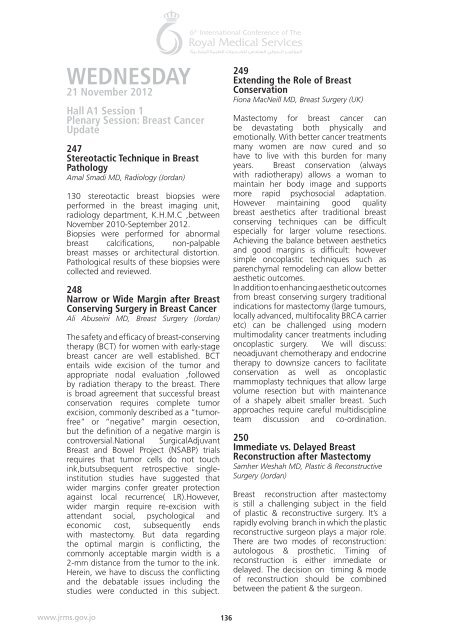Abstract book 6th RMS 16.indd
Abstract book 6th RMS 16.indd
Abstract book 6th RMS 16.indd
You also want an ePaper? Increase the reach of your titles
YUMPU automatically turns print PDFs into web optimized ePapers that Google loves.
WEDNESDAY<br />
21 November 2012<br />
Hall A1 Session 1<br />
Plenary Session: Breast Cancer<br />
Update<br />
247<br />
Stereotactic Technique in Breast<br />
Pathology<br />
Amal Smadi MD, Radiology (Jordan)<br />
130 stereotactic breast biopsies were<br />
performed in the breast imaging unit,<br />
radiology department, K.H.M.C ,between<br />
November 2010-September 2012.<br />
Biopsies were performed for abnormal<br />
breast calcifications, non-palpable<br />
breast masses or architectural distortion.<br />
Pathological results of these biopsies were<br />
collected and reviewed.<br />
248<br />
Narrow or Wide Margin after Breast<br />
Conserving Surgery in Breast Cancer<br />
Ali Abuseini MD, Breast Surgery (Jordan)<br />
The safety and efficacy of breast-conserving<br />
therapy (BCT) for women with early-stage<br />
breast cancer are well established. BCT<br />
entails wide excision of the tumor and<br />
appropriate nodal evaluation ,followed<br />
by radiation therapy to the breast. There<br />
is broad agreement that successful breast<br />
conservation requires complete tumor<br />
excision, commonly described as a “tumorfree”<br />
or “negative” margin oesection,<br />
but the definition of a negative margin is<br />
controversial.National SurgicalAdjuvant<br />
Breast and Bowel Project (NSABP) trials<br />
requires that tumor cells do not touch<br />
ink,butsubsequent retrospective singleinstitution<br />
studies have suggested that<br />
wider margins confer greater protection<br />
against local recurrence( LR).However,<br />
wider margin require re-excision with<br />
attendant social, psychological and<br />
economic cost, subsequently ends<br />
with mastectomy. But data regarding<br />
the optimal margin is conflicting, the<br />
commonly acceptable margin width is a<br />
2-mm distance from the tumor to the ink.<br />
Herein, we have to discuss the conflicting<br />
and the debatable issues including the<br />
studies were conducted in this subject.<br />
249<br />
Extending the Role of Breast<br />
Conservation<br />
Fiona MacNeill MD, Breast Surgery (UK)<br />
Mastectomy for breast cancer can<br />
be devastating both physically and<br />
emotionally. With better cancer treatments<br />
many women are now cured and so<br />
have to live with this burden for many<br />
years. Breast conservation (always<br />
with radiotherapy) allows a woman to<br />
maintain her body image and supports<br />
more rapid psychosocial adaptation.<br />
However maintaining good quality<br />
breast aesthetics after traditional breast<br />
conserving techniques can be difficult<br />
especially for larger volume resections.<br />
Achieving the balance between aesthetics<br />
and good margins is difficult: however<br />
simple oncoplastic techniques such as<br />
parenchymal remodeling can allow better<br />
aesthetic outcomes.<br />
In addition to enhancing aesthetic outcomes<br />
from breast conserving surgery traditional<br />
indications for mastectomy (large tumours,<br />
locally advanced, multifocality BRCA carrier<br />
etc) can be challenged using modern<br />
multimodality cancer treatments including<br />
oncoplastic surgery. We will discuss:<br />
neoadjuvant chemotherapy and endocrine<br />
therapy to downsize cancers to facilitate<br />
conservation as well as oncoplastic<br />
mammoplasty techniques that allow large<br />
volume resection but with maintenance<br />
of a shapely albeit smaller breast. Such<br />
approaches require careful multidiscipline<br />
team discussion and co-ordination.<br />
250<br />
Immediate vs. Delayed Breast<br />
Reconstruction after Mastectomy<br />
Samher Weshah MD, Plastic & Reconstructive<br />
Surgery (Jordan)<br />
Breast reconstruction after mastectomy<br />
is still a challenging subject in the field<br />
of plastic & reconstructive surgery. It’s a<br />
rapidly evolving branch in which the plastic<br />
reconstructive surgeon plays a major role.<br />
There are two modes of reconstruction:<br />
autologous & prosthetic. Timing of<br />
reconstruction is either immediate or<br />
delayed. The decision on timing & mode<br />
of reconstruction should be combined<br />
between the patient & the surgeon.<br />
www.jrms.gov.jo<br />
136

















